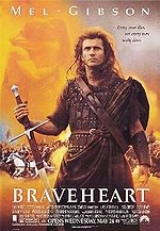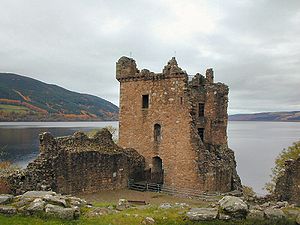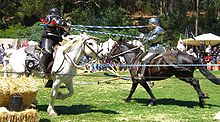
Warfare of Scotland in the High Middle Ages
Encyclopedia
The Scottish army of the High Middle Ages for the purposes of this article pertains to the fighting men and military systems that existed in Scotland
between the death of Domnall II
in 900, and the death of Alexander III
in 1286, which fell before and indirectly led to the military conflict known as the Scottish Wars of Independence.
-raiding, though this would seem to have disappeared by the middle of the 12th century. Presumably, they did so with each other. However, our main record of it comes from when they practised it against their Norman and pre-Conquest Anglo-Saxon neighbour. John Gillingham argues that this was one of the things which made the Scots (and other Celts) particularly barbarous in the eyes of their "Frankish" neighbours, because the French had largely abandoned this form of warfare. Symeon of Durham
writes,
The Máel Coluim here was King Máel Coluim III, and this raid took place in 1070, the same year he married an Anglo-Hungarian princess called Margaret
(later canonised). His saintly, continentalised Saxon wife however did not stop more of these raids against the English people
. Both Symeon and the Anglo-Saxon chronicle
record future raids, particularly in 1079. However, by the middle of the twelfth century, the Scots had stopped launching slave raids.
 As with so many changes in this period, the introduction of the feudal army can be traced primarily to the reign of David I, although French and English knights were used in moderation by his older brothers. The tension which these knights produced is well recorded in contemporary sources. At the Battle of the Standard
As with so many changes in this period, the introduction of the feudal army can be traced primarily to the reign of David I, although French and English knights were used in moderation by his older brothers. The tension which these knights produced is well recorded in contemporary sources. At the Battle of the Standard
, the Gaels oppose the positioning of the French soldiers in the van of the king's army. Ailred of Rievaulx
attributes this opposition to the Galwegians, but we know it was the Scottish Gaels in general, as the native spokesman is given as Máel Ísu, then the Mormaer of Strathearn and highest ranking noble in the army. Ailred reports a long speech by Robert de Brus, a former vassal of David who berates the King for betraying his people by invading Norman England with a host of Gaelic barbarians. David is nevertheless forced to give the right to the Gaels, and in the account of Ailred, this is the main reason for the Scottish defeat.
Despite this, over the next century and a half, the feudal French way of warfare took strong root in Scotland. David uses French soldiers to manage the frontier between his lands in the old Kingdom of Strathclyde and the Norse-Gaelic west, establishing what are essentially marcher lordships in Renfrew
(the Stewart Lordship of Strathgryfe
), Annandale (granted to Robert de Brus) and Cunningham. In the thirteenth century, French-speaking noble families, especially the Comyns, rose to the top of the Scottish nobility by taking over Mormaer
doms, such as Buchan, Menteith and Angus. .
 The advantage French military culture possessed was manifold. French knights used expensive suits of armour, whereas the Scots were "naked" (of armour, rather than dress). They possessed heavy cavalry, weapons such as crossbows, siege engines and fortification techniques far more effective and advanced than anything possessed by the native Scots. Moreover, their culture, particularly their feudal ideology, made them reliable vassals, who because they were foreign, were even more dependent on the king. Over time, the Scots, like the English, themselves became more like the French warriors, and the French warriors adopted many of the Gaelic military practices, so that by the end of the period, a syncretic military culture existed in the kingdom.
The advantage French military culture possessed was manifold. French knights used expensive suits of armour, whereas the Scots were "naked" (of armour, rather than dress). They possessed heavy cavalry, weapons such as crossbows, siege engines and fortification techniques far more effective and advanced than anything possessed by the native Scots. Moreover, their culture, particularly their feudal ideology, made them reliable vassals, who because they were foreign, were even more dependent on the king. Over time, the Scots, like the English, themselves became more like the French warriors, and the French warriors adopted many of the Gaelic military practices, so that by the end of the period, a syncretic military culture existed in the kingdom.
It has been suggested that when the feudal army was destroyed at the Battle of Dunbar (1296)
, the Scots were dependent once again on the Gaelic army. However, Dunbar would seem to have been a clash between Scottish and Englishmen-at-arms. There is little evidence to indicate a general engagement, owing to two centuries of adaptation and the leadership of Robert Bruce, the Scottish army (both Gaelic and English-speaking) was able to defeat the attempted takeover by the English-crown.
Scotland
Scotland is a country that is part of the United Kingdom. Occupying the northern third of the island of Great Britain, it shares a border with England to the south and is bounded by the North Sea to the east, the Atlantic Ocean to the north and west, and the North Channel and Irish Sea to the...
between the death of Domnall II
Donald II of Scotland
Domnall mac Causantín , anglicised as Donald II was King of the Picts or King of Scotland in the late 9th century. He was the son of Constantine I...
in 900, and the death of Alexander III
Alexander III of Scotland
Alexander III was King of Scots from 1249 to his death.-Life:...
in 1286, which fell before and indirectly led to the military conflict known as the Scottish Wars of Independence.
Warriors and warfare
After the "Norman Conquest" of David I, the warriors of Scotland can be classed as of two types. Firstly, the native exercitus Scoticanus (i.e. "Scottish army", also 'common army'); and, secondly, the exercitus militaris (i.e. "feudal army").Gaelic army
The Common Army army formed the larger part of all pre-Stewart Scottish armies, but in the wider world of European (i.e. French) chivalry the feudal section was the more prestigious. The native Scots, like all early medieval Europeans, practiced organized slaveSlavery
Slavery is a system under which people are treated as property to be bought and sold, and are forced to work. Slaves can be held against their will from the time of their capture, purchase or birth, and deprived of the right to leave, to refuse to work, or to demand compensation...
-raiding, though this would seem to have disappeared by the middle of the 12th century. Presumably, they did so with each other. However, our main record of it comes from when they practised it against their Norman and pre-Conquest Anglo-Saxon neighbour. John Gillingham argues that this was one of the things which made the Scots (and other Celts) particularly barbarous in the eyes of their "Frankish" neighbours, because the French had largely abandoned this form of warfare. Symeon of Durham
Symeon of Durham
Symeon of Durham was an English chronicler and a monk of Durham Priory. When William of Saint-Calais returned from his Norman exile in 1091, Symeon was probably in his company...
writes,
The Máel Coluim here was King Máel Coluim III, and this raid took place in 1070, the same year he married an Anglo-Hungarian princess called Margaret
Saint Margaret of Scotland
Saint Margaret of Scotland , also known as Margaret of Wessex and Queen Margaret of Scotland, was an English princess of the House of Wessex. Born in exile in Hungary, she was the sister of Edgar Ætheling, the short-ruling and uncrowned Anglo-Saxon King of England...
(later canonised). His saintly, continentalised Saxon wife however did not stop more of these raids against the English people
Anglo-Saxons
Anglo-Saxon is a term used by historians to designate the Germanic tribes who invaded and settled the south and east of Great Britain beginning in the early 5th century AD, and the period from their creation of the English nation to the Norman conquest. The Anglo-Saxon Era denotes the period of...
. Both Symeon and the Anglo-Saxon chronicle
Anglo-Saxon Chronicle
The Anglo-Saxon Chronicle is a collection of annals in Old English chronicling the history of the Anglo-Saxons. The original manuscript of the Chronicle was created late in the 9th century, probably in Wessex, during the reign of Alfred the Great...
record future raids, particularly in 1079. However, by the middle of the twelfth century, the Scots had stopped launching slave raids.
Feudal army

Battle of the Standard
The Battle of the Standard, sometimes called the Battle of Northallerton, in which English forces repelled a Scottish army, took place on 22 August 1138 on Cowton Moor near Northallerton in Yorkshire. The Scottish forces were led by King David I of Scotland...
, the Gaels oppose the positioning of the French soldiers in the van of the king's army. Ailred of Rievaulx
Ailred of Rievaulx
Aelred , also Aelred, Ælred, Æthelred, etc., was an English writer, abbot of Rievaulx , and saint.-Life:...
attributes this opposition to the Galwegians, but we know it was the Scottish Gaels in general, as the native spokesman is given as Máel Ísu, then the Mormaer of Strathearn and highest ranking noble in the army. Ailred reports a long speech by Robert de Brus, a former vassal of David who berates the King for betraying his people by invading Norman England with a host of Gaelic barbarians. David is nevertheless forced to give the right to the Gaels, and in the account of Ailred, this is the main reason for the Scottish defeat.
Despite this, over the next century and a half, the feudal French way of warfare took strong root in Scotland. David uses French soldiers to manage the frontier between his lands in the old Kingdom of Strathclyde and the Norse-Gaelic west, establishing what are essentially marcher lordships in Renfrew
Renfrew
-Local government:The town of Renfrew gave its name to a number of local government areas used at various times:*Renfrew a town to the west of Glasgow*Renfrewshire, the present unitary local council area in which Renfrew is situatated....
(the Stewart Lordship of Strathgryfe
Strathgryfe
Strathgryffe or Gryffe Valley is a strath or wide valley centred on the River Gryffe in the west central Lowlands of Scotland....
), Annandale (granted to Robert de Brus) and Cunningham. In the thirteenth century, French-speaking noble families, especially the Comyns, rose to the top of the Scottish nobility by taking over Mormaer
Mormaer
The title of Mormaer designates a regional or provincial ruler in the medieval Kingdom of the Scots. In theory, although not always in practice, a Mormaer was second only to the King of Scots, and the senior of a toisech.-Origin:...
doms, such as Buchan, Menteith and Angus. .

It has been suggested that when the feudal army was destroyed at the Battle of Dunbar (1296)
Battle of Dunbar (1296)
The Battle of Dunbar was the only significant field action in the campaign of 1296. King Edward I of England had invaded Scotland in 1296 to punish King John Balliol for his refusal to support English military action in France.-Background:...
, the Scots were dependent once again on the Gaelic army. However, Dunbar would seem to have been a clash between Scottish and Englishmen-at-arms. There is little evidence to indicate a general engagement, owing to two centuries of adaptation and the leadership of Robert Bruce, the Scottish army (both Gaelic and English-speaking) was able to defeat the attempted takeover by the English-crown.

